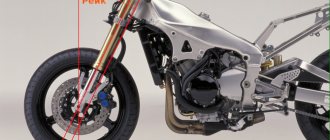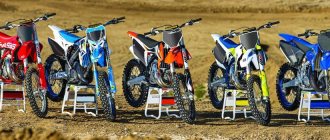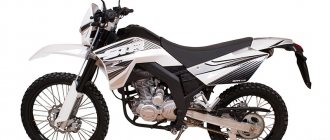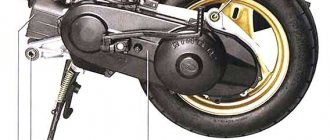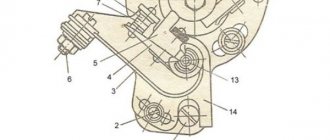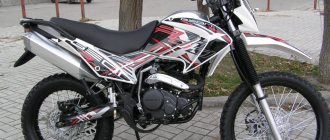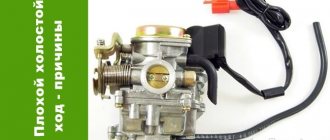You know, I’ve been wanting this motorcycle for a long time. A year ago, when my xjr400 was stolen, I was already thinking about it. The problem was that there was terribly little information on this motorcycle on the Internet. Therefore, I will try to leave this reviewer here with your permission.
I’m not talking about reviews of sellers with dry technical information, but about user reviews. Somewhere there’s a video on YouTube about how to adjust the suspension, somewhere there’s a promo video with a friend lifting this Geon/Shineray onto a rack, here and there epic videos like “first 500 km, review” (generally a mega-useful video about a motorcycle for touring), but I wanted information in the style of “I drove 10,000 km, a wheel fell off.” I’m lying, I wanted the opposite, but the “made in China” stamp, just in case, painted a non-optimistic picture.
I’m not a pro-reviewer, not even a semi-pro, but I hope that my reasoning will help someone with the choice “to take/not to take.” I admit that I have only been the owner of this motorcycle for 3000 km, but I had plenty of opportunity to keep an eye on it, because its first owner is my teammate and, more than once, a ride-along rider nearby.
A year ago we received it from the factory, unpacked it and put it together.
Let's warm up with dry technical information:
Engine capacity: 399cc Dry weight: 150 kg (old version with a plastic tank. Mine according to PTS weighs 162) Wheelbase: 1450 mm Power: 30 hp at 7000 rpm Torque: 32 Nm at 5500 rpm Tank volume: 18 liters for plastic (for some reason 16 for metal) Tires: front 90/90-21 rear 130/80-18 Maximum speed: 140 km/h
Let me make a reservation right away that these figures are for the carburetor version released for the domestic market. In Eastern Europe there is an injection version and I’m quietly thinking about how to install an injector for myself, while slightly violating the Chinese rules, otherwise here they simply won’t extend the motorcycle for a year for the slightest changes...
So, why exactly this Geon/Shineray: 1) midwestern China, the foothills of Tibet, chronic small and large earthquakes, landslides and similar crap, so sports tours or classics may simply not pass. With your permission, I’ll call it turanda, but turanda is the best option. 2) wild prices for imports, so you don’t really want to buy it. 3) older imports simply don’t work, 13-year-old equipment must be disposed of... and so would old Africa... mmm... okay, away with empty thoughts. 4) among the Chinese motorcycle industry in the touring category, this Geon/Shineray is the most powerful. There is another car, the JH600, but I don’t like it because of its weaker suspension and, let’s be honest, just a gloomy appearance...
Now I’ll try to get closer to the actual pros and cons of this unit:
Pros: + Nice easy maneuverability. The Chinese managed to fit in a dry sump engine, the handling of the motorcycle is similar to my Chinese cross-country bike. The center of gravity is low and, despite the height of the motorcycle, it turns wonderfully. Even in traffic jams and jams.
+ Fast Ace suspension - a definite win. I'm afraid to lie, but this is the best that the Chinese put on their motorcycles. The Nastarev fork and rear monoshock provide a lot of possibilities - from the track, to off-road with a load and a passenger, and trying to get out on our enduro-type track-that-we-invented-for-ourselves. I didn’t go far thanks to the dual-sport tires, but I allowed myself to jump a little from mini-jumping boards and go on slides 2-3 meters high and 40 degrees incline upward. On the highway it absorbs bumps just like a charm.
+ decent ground clearance
+ motorcycle size. The domestic market ketais always seemed small to me. Well, it so happened that the average height and size of a local rider is inferior to me, although I am far from gigantic in size. The motorcycle does not seem like a toy scooter. The seat height is impressive for a Chinese 890mm!!! My height is 180, my weight is 80. This is also a slight disadvantage for smaller riders. My wife held the motorcycle only because I managed to grab it - her 163cm and 50kg weight is not enough to hold the motorcycle on both toes. While it may be able to pass in the city, in off-road conditions, where you have to secure the motorcycle with your feet, there is literally no way for it at all.
+ tank consumption of 16 liters in mixed mode, half city-highway - about 350 km. Naturally, if you don’t burn rubber at every traffic light.
+ not bad (but not ideal stock tires). The front roller was replaced after 15,000. The rear one is still holding up. I think I’ll replace it before winter, when I reach 20,000 km. The grip is good both in rain and sun, but in the mud, predictably, I would like the tires to be a little tougher. The photo shows the rear roller after 16,000 km
+ pleasant ductility of the engine (for a Chinese). Loaded with a passenger, I had a great time riding these shameful 30 horses at traffic lights so as not to ride in the traffic. And it was just as good at making its way through roads without asphalt.
+ general wear and tear. Knowing Chinese technology firsthand, I am really amazed by the external condition of this motorcycle. Although it fell and spent the whole working day in the parking lot in the rain, the units look, if not like new, then at least not the way I’m used to seeing other Chinese units with similar mileage. The only let down was the exhaust pipe, which was clearly not of the highest quality metal.
Now about the minuses, where would we be without them: - just a trashy stock chain. The previous owner changed the chain 2000 km before selling the motorcycle to me and replaced it with the same one as stock. In 500 km I pulled it up twice. The issue was resolved by purchasing the Regina chain, the issue of the chain disappeared. 2500 km without braces.
— the stock light is as dull as the stock circuit, despite the fact that there are two lamps. You can't see a thing. The issue was almost resolved by purchasing LED lamps. Still, I'm thinking about buying additional flashlights. Honestly, it's not enough. I won’t drive with this light on a dark night road at 80 km/h. In the city it was all right, but outside the city... Plus, no matter how I tried to adjust it, Uncle Liao, who designed this motorcycle, clearly set the high beam to blind crows. It hits sooooo high. Friends have told me that my neighbor seems far away when I drive towards them.
- incomprehensible Chinese quality. There are 4 such motorcycles in the team and so far the ratio of epic wins to epic failures is 3:1. But 75% is not so much compared to the Japanese or Germans, where factory defects are considered a rare exception to the rule. One local colleague replaced a cracked pendulum twice in a year and a rear monoshock absorber once. Frankly, knowing this comrade, I am not surprised - on the last motorcycle the frame cracked. But it still made me think. Mine... distracted, knocking on wood... so far behaving normally.
- seat. I don’t have much experience with long-distance motorcycles suitable for this, but the bike is a little narrow and a little harsh. We plan to entrust my wife, as a person who has better knowledge of applied tools than me, with the installation of new silicone inserts. The last race of 270 km in a day (considering the slow road along a mountain serpentine road of 40-50 km/h and light stops for a smoke break) made my butt think. No, not everything is so fatal, on the same xjr400 I would curse this road, but still I expected something more serious
- FUCKING NEUTRAL!!! And this is a common problem among our four motorcycles. It is IMPOSSIBLE to catch neutral while standing in first!!! I have already accustomed myself when braking at a traffic light: 4,3,2,1,2, a slight click down. There is no way to click up on the first one. If you blow on the paw, it’s already the second one. I'm used to it - yes. It still infuriates me - yes.
- front brake. If during everyday driving without a load it is enough, then with a passenger and panniers the brake becomes frankly weak. After the same trips on the xjr400, it feels like it’s almost gone. To be honest, the Chinese cross-country racer on checkers brakes not much worse, although the brakes there are also the same as Chinese.
- naturally, 400 Chinese cubes are not 400 Japanese ones. Feels like a sticky 250. The maximum speed that we managed to develop with a passenger and panniers is 125. I understand that the aerodynamics spoiled by the panniers also have an effect, but for our tourists, who are 125 on the highway, this is “Am I a sucker?” a motorcycle is clearly not suitable. Up to 100 it takes off briskly, but beyond that, not so much.
Conclusions: Am I satisfied? Undoubtedly. This is the first Chinese person in my memory who, after getting to know him more closely, began to inspire a certain amount of trust. Not absolute, but nonetheless. For the purposes of leisurely motorcycle touring with occasional trips off the road, the motorcycle is perfect. The Chinese have finally learned how to tighten nuts properly. The previous owner dropped the motorcycle epically on his longest trip. The motorcycle simply turned over and became upside down. I have no idea how this happened. The only damage was a broken windshield. No other problems were noticed, so the owner, having removed the stubs of the windshield, finished the long drive and drove another 4,500 km without intervention, safely returning home along the following route:
Well, a few photos from the previous owner for objectivity, so that there would be no comments like “after 17,000 km it’s normal only because we rode in a supermarket parking lot”
Thanks to those who read. Hope it helps 
Geon Grand Tour 400 and Shineray X-Trail 250: review, comparison, problems
What does this table say at first glance? About the fact that Geon is bigger, more powerful and more advanced? Theoretically, it is more interesting than its younger brother (yes, exactly his brother, since the “Geon Grand Tour” is in reality a Shineray XY400GY-X5, and both of them are somewhat reminiscent of the Honda XRE 300). What else is there on the Grand Tour:
- It comes with an oring chain from the factory, while the Ixtrail has a reinforced one, but without oil seals.
- He has a trip computer and a watch.
- Excellent universal Kendo tires come from the factory
- Larger wheels
- It is protected.
- Powerful aluminum swingarm
It would seem that the Grand Tour 400 is a complete improvement over the X-Trail, but if that were the case, I would not be writing this review. I'm writing this for one simple reason: I like the X-Trail much better. And if you think about it, the advantages of the Grand Tour are not such advantages.
- The first time you replace the chain, buy an original one. No modifications, no additional investments, the budget is the same as in the first case.
- I don't know what tires are on the X-Trail. Simply because she didn't give me a reason to even lean over and read. Normal tires, and in the city, and on the highway, and on sand, and on primer, and on crushed stone, it goes without problems. Not Kendo. But Kendo, frankly speaking, is not Metzeller. For a motorcycle with a maximum speed of 120, no special tires are needed.
- Large wheels mean a higher motorcycle height. Even for me, with my height of two meters, it was difficult to drive along the country roads and gullies in a GT. You have to put your foot on the ground, but there is no ground! I dropped my motorcycle a couple of times.
- Protection is cool, useful, safe. But damn, this is heavy! And to the protection we add two exhaust pipes (with one cylinder), multiply by high wheels and we get a strange device of unknown purpose.
And it turns out that the Grand Tour is not an enduro at all. Then maybe a tourist? Moreover, it is called Grand Tour, which seems to hint at travel...
But then all the adjustable fork settings and twenty-centimeter suspension travel are needed only so that the pilot’s ass is not knocked off by the seat. The GT seat is hard, narrow and uncomfortable; after 200 km on a good highway you will howl and try to postpone the trip until the day after tomorrow. No amount of adjustment will save your ass from one hefty bruise.
Also, the maximum comfortable speed of the Grand Tour is 110 km/h. Exactly the same as on the X-Trail 250. At higher speeds, both motorcycles skid and blow away from the trajectory. There is no dynamics at speeds above 100, either here or there. But you don’t expect anything else from a “check” for one and a half thousand dollars, but a motorcycle for three and a half could ride more interestingly.
He could, but he doesn't go. There are two reasons. The main one is the engine. The carburetor engine from the Honda XR400, copied by the Chinese, was modified to accept an injector from Delphi. Thanks to this, consumption has decreased, but along with it, power has also decreased. 28 hp with 400 cubic meters it’s funny. The Honda weighs 121 kg and with a standard engine has a maximum speed of 135, Geon weighs 50% more, but in reality I was able to accelerate it to 125, with a tailwind, from a hill. The engine rests at 6500 rpm and does not want to accelerate the device any further.
One might assume that Shineray 250 is doing even worse, but no. Due to well-thought-out gear ratios and a 50 kg lighter weight, the motorcycle accelerates very briskly. The low center of gravity makes it more stable. The suspension from the factory is set up just as comfortably as I managed to set up the FastAce on the Geon in a month and a half of torment. By the way, the factory oil (or what is the correct name for this vile slurry?) in FastAce shock absorbers needs to be changed, if not immediately, then definitely within the first thousand kilometers. I didn’t do this, and by two thousand the fork sank about seven centimeters simply under its own weight.
